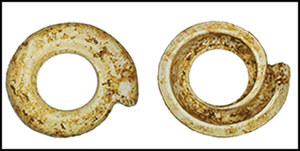Crossref Citations
This article has been cited by the following publications. This list is generated based on data provided by
Crossref.
Valentin, Frédérique
2021.
Des cadavres dans nos poubelles : restes humains et espaces détritiques de la Préhistoire à nos jours.
Bulletins et mémoires de la société d'anthropologie de Paris,
Vol. 33,
Issue. 2,
Tacail, Théo
Martin, Jeremy E.
Herrscher, Estelle
Albalat, Emmanuelle
Verna, Christine
Ramirez-Rozzi, Fernando
Clark, Geoffrey
Valentin, Frédérique
and
Balter, Vincent
2021.
Quantifying the evolution of animal dairy intake in humans using calcium isotopes.
Quaternary Science Reviews,
Vol. 256,
Issue. ,
p.
106843.
REEPMEYER, CHRISTIAN
FERGUSON, REDBIRD
VALENTIN, FRÉDÉRIQUE
and
CLARK, GEOFFREY R.
2021.
The stone adze and obsidian assemblage from the Talasiu site, Kingdom of Tonga.
Archaeology in Oceania,
Vol. 56,
Issue. 1,
p.
1.
Miszkiewicz, Justyna J.
Valentin, Frédérique
Vrahnas, Christina
Sims, Natalie A.
Vongsvivut, Jitraporn
Tobin, Mark J.
and
Clark, Geoffrey
2021.
Bone loss markers in the earliest Pacific Islanders.
Scientific Reports,
Vol. 11,
Issue. 1,
Fenner, Jack N.
Herrscher, Estelle
Valentin, Frédérique
and
Clark, Geoffrey
2021.
An isotopic analysis of Late Lapita and State Period diets in Tonga.
Archaeological and Anthropological Sciences,
Vol. 13,
Issue. 1,
Clark, Geoffrey
and
Litster, Mirani
2022.
Archaeological Perspectives on Conflict and Warfare in Australia and the Pacific.
p.
1.
Petchey, Fiona
Dabell, Kathleen
Clark, Geoffrey
and
Parton, Phillip
2023.
Evidence of temporal changes in the marine 14C reservoir in the South Pacific and implications for improved dating resolution across a radiocarbon plateau (2600-2350 cal BP).
Journal of Archaeological Science,
Vol. 153,
Issue. ,
p.
105756.
Hayes, Susan
Buckley, Hallie R.
Valentin, Frédérique
Bedford, Stuart
and
Spriggs, Matthew
2024.
aDNA, ethnography, and facial approximations of the Teouma Lapita burials (c. 3000BP).
Journal of Archaeological Science,
Vol. 162,
Issue. ,
p.
105916.
Herrscher, Estelle
Valentin, Frédérique
Zinger, Wanda
Pradier, Baptiste
André, Guy
and
Milella, Marco
2024.
Life histories in Fiji as reconstructed from first millennium CE Sigatoka Sand Dune burials using isotopes.
PLOS ONE,
Vol. 19,
Issue. 5,
p.
e0300749.
Parton, Phillip
and
Clark, Geoffrey
2024.
Low-Density Urbanisation: Prestate Settlement Growth in a Pacific Society.
Journal of Archaeological Method and Theory,
Vol. 31,
Issue. 3,
p.
1485.
Kaharudin, Hendri A. F.
O’Connor, Sue
Kroh, Andreas
and
Kealy, Shimona
2025.
Staple or delicacy: Sea urchin exploitation over the last 40,000 years at Makpan Cave, Alor Island.
Journal of Island and Coastal Archaeology,
Vol. 20,
Issue. 3,
p.
628.


